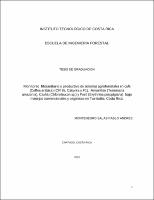| dc.contributor.advisor | Meza Montoya, Alejandro | |
| dc.contributor.author | Montenegro Salas, Pablo Andrés | |
| dc.contributor.author | Instituto Tecnológico de Costa Rica, Cartago (Costa Rica) Escuela de Ingeniería Forestal | |
| dc.contributor.author | CATIE – Centro Agronómico Tropical de Investigación y Enseñanza, Turrialba, Costa Rica. | |
| dc.date.accessioned | 2022-03-01T15:59:26Z | |
| dc.date.available | 2022-03-01T15:59:26Z | |
| dc.date.issued | 2010 | |
| dc.identifier.uri | https://repositorio.catie.ac.cr/handle/11554/11664 | |
| dc.description | Tesis (Lic. Sc.) – CATIE, Turrialba (Costa Rica), 2010 | es_ES |
| dc.description | 90 páginas : 33 ilustraciones, 11 tablas. | |
| dc.description | Bibliografía páginas 79-85 | |
| dc.description | Tesis en español con resumen en inglés. | |
| dc.description.abstract | El presente trabajo se realizó en un ensayo de sistemas agroforestales de café (Coffea arabica) variedad Caturra, CR95 y el híbrido F1, con sombra de Erythrina poeppigiana, Terminalia amazonia y Chloroleucon eurycyclum, así como con la combinación de estas especies y un testigo a pleno sol, bajo los manejos convencionales (altos y medios) y orgánicos (intensivos y bajos). Los tratamientos están establecidos en un diseño de parcelas divididas, en donde las parcelas principales son las condiciones de sombra, las subparcelas corresponden al manejo de insumos y como sub-subparcelas cada tipo o variedad de café. También dentro de cada sub-subparcela se determinaron las variables dasométricas de los árboles presentes y se determinó el porcentaje de dosel ocupado por los árboles en dos puntos, uno al norte y otro al sur de la subsubparcela. Con una base de datos de 6 años se procedió a determinar los niveles de productividad en las parcelas y sub-subparcelas presentes en el ensayo. La roya no presentó incidencias arriba del nivel crítico en ninguno de los tratamientos. La especie que aporta los mejores rendimientos en madera es cashá; sola y en asocio con poró. La productividad (fanegas/ha) del ensayo superó o igualó en casi todos los tratamientos a los promedios nacionales y los valores más altos se dieron en los tratamientos Poró-F1-BO, Cashá-Poró-CR95-BO y Poró-CR95-BO, por otra parte los resultados más bajos estuvieron en Amarillón-Caturra-BO y Amarillón-F1-MC, otros tratamientos dieron resultados buenos en relación a productividad incluso superando los promedios que reporta el ICAFE. | es_ES |
| dc.description.abstract | The study was conducted in a trial of agroforestry coffee (Coffea arabica) variety Caturra, CR95 and the F1 hybrid with Erythrina poeppigiana, Terminalia amazonia and Chloroleucon sp and with the combination of these species and a witness in full sun, under the conventional management (top and middle) and organic (intensive and lower). Treatments are established in a split plot design, where the main plots are shaded conditions, the subplots correspond to the input management sub-subplots as each type or variety of coffee. Also within each sub-subplot were determined for tree dasometrics present and determined the percentage of tree canopy occupied by two points, one north and one south of the sub-subplot. With a database of six years was determined productivity levels in the plots, subplots and sub-subplots present in the test. “La roya” did not submit incidence above the critical level in any of the treatments. The species that gives the best yield in wood is cash, alone and in association with pore. Productivity (bushels / ha) exceeded or equaled the test in almost all treatments than the national average and the highest values were observed in the treatments Poró-F1-BO-Cash-pore and pore-BO CR95-CR95-BO On the other hand the lowest scores were in Amarillón-Caturra-BO and Amarillón-F1-MC, other treatments gave good results in relation to productivity surpassing the averages reported ICAFE. | |
| dc.format.extent | 90 páginas | es_ES |
| dc.language.iso | es | es_ES |
| dc.publisher | CATIE | es_ES |
| dc.subject | COFFEA ARABICA | es_ES |
| dc.subject | HEMILEIA VASTATRIX | es_ES |
| dc.subject | CERCOSPORA COFFEICOLA | es_ES |
| dc.subject | MYCENA CITRICOLOR | es_ES |
| dc.subject | COLLETOTRICHUM | es_ES |
| dc.subject | LEUCOPTERA COFFEELLA | es_ES |
| dc.subject | TERMINALIA AMAZONIA | es_ES |
| dc.subject | CHLOROLEUCON EURYAYCLUM | es_ES |
| dc.subject | ERYTHRINA POEPPIGIANA | es_ES |
| dc.subject | VARIEDADES | es_ES |
| dc.subject | SOMBRA | es_ES |
| dc.subject | ARBOLES DE SOMBRA | es_ES |
| dc.subject | ENFERMEDADES DE LAS PLANTAS | es_ES |
| dc.subject | PLANTACION | es_ES |
| dc.subject | AGROFORESTERIA | es_ES |
| dc.subject | COSTA RICA | es_ES |
| dc.subject.other | Sede Central | es_ES |
| dc.title | Monitoreo fitosanitario y productivo de sistemas agroforestales en café (Coffea arabica) (CR 95, Caturra y F1), Amarillón (Terminalia amazonia), Cashá (Chloroleucon sp.) y Poró (Erythrina poeppigiana) bajo manejos convencionales y orgánicos en Turrialba, Costa Rica | es_ES |
| dc.type | Tesis | es_ES |
| dc.identifier.status | openAccess | es_ES |
| dc.subject.sdg | ODS 12 - Producción y consumo responsables | es_ES |


